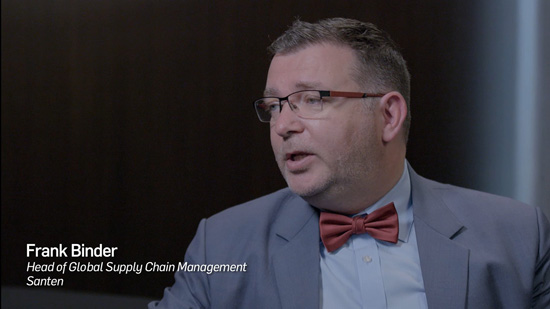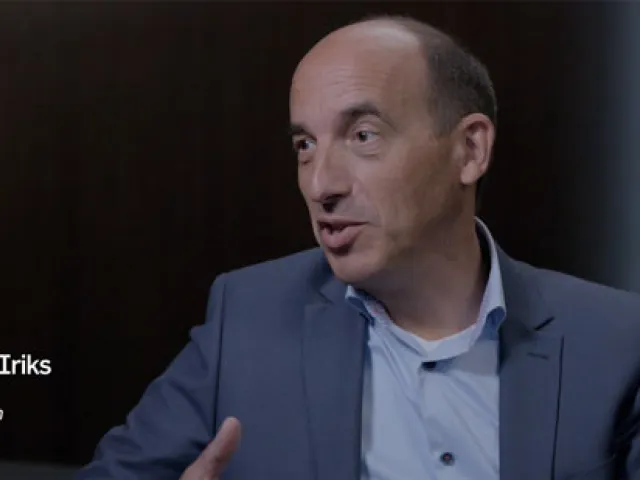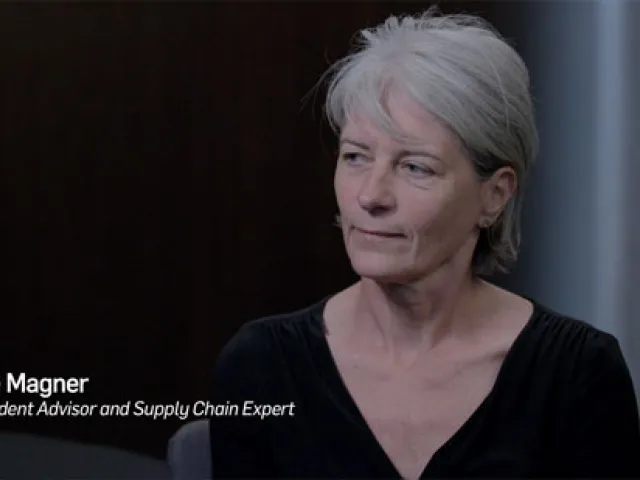Table of contents
Key Takeaways
- The role of supply chain is changing from “pallet pushers” to business partners.
- Greater visibility into product flow enables operational planning and improvement.
- Companies need to prioritize change management over technical solutions.

Frank Binder, head of global supply chain management at Santen Pharmaceutical, joins TraceLink's Digital Strategist Roddy Martin to discuss how Santen's supply chain team successfully transitioned from working in a silo to serving as strategic business partners—and how product serialization will allow Santen to gain better operational intelligence and drive business growth.
Transcript:
Roddy Martin: Frank, good to be here with you. Maybe you'd like to introduce yourself and talk a little bit about how in your organization, in your strategy, you see that convergence starting to take shape, that pivot or morph, whatever you want to call it, of serialization capabilities into supply chain. Not to say that it's been done, but how you see it evolving.
Frank Binder: Sure, Roddy. I'm Frank Binder. I'm the Global Head of Supply Chain Management at Santen. We are a company focusing on ophthalmology, which is a niche within pharma. We are a Japanese company in the process of becoming global. It does quite a lot of good for everyone, including supply chain management, to embrace global processes, global approaches, and global systems.
Roddy: Good. If I can read into that, what I would anticipate is, you have been putting the standards in place. That makes the convergence of serialization and supply chain, I wouldn't say easy because nothing is ever easy, but it makes it a little more of less painful.
Frank: You're right. It's not easy, and it will not be easy, but at least I think we have some directions to go. I think there's two elements when you talk about convergence of serialization with supply chain. One is using the serial numbers themselves, especially downstream with our logistics partner.
We know we will not be able to have...at least the way the systems are set up today, to have the full transparency, but at least we can establish that within our area of responsibility. As long as the products are under our own care, we can track and we should track them as far downstream as we can.
That will help us to understand the flaws in the market. That will help us also to get some investigations done, if necessary. On the other hand, and maybe that's longer‑term, the more interesting element is to use the network that has been created to cope with serialization, to use that network to enable other business processes.
Roddy: We know, and a lot of supply chain leaders always say to me, "The problem is I don't have visibility." When you talk about visibility, if we get real about visibility, visibility of what? If you have those serialization and track and trace processes, the basis of visibility, you've got quite a big substantial base for running the supply chain. Would that be a fair comment?
Frank: Absolutely. I think it would give us a better handle on the things that are really going on, so that we can really know, "Okay, we have some products at some place, and that is the path they have taken."
Certainly, in some situations, for example, when there is a question being asked about whether something has happened that might not have been legal or so on, we have to investigate. And it’s valuable to have as much information as we can have. It's also valuable for us to understand how a product flows.
I think this is something that we as supply chain people want to understand as much as possible because then we can adapt our own planning and our own operations to that
Roddy: Even improve if you need to.
Frank: Yes, definitely.
Roddy: If you think about serialization and track and trace, it's providing you this basis of reengineering business processes, and even introducing new digital technologies. Is that a lens that you look at?
In other words, as you're going through mapping and modeling the serialization track and trace, do you say, there is an opportunity where we could implement something digital and get a 10 times improvement in cycle times, or whatever the case may be?
Frank: Yeah. I think as we start to study the process in detail, digitize the business processes, and link them up via our network, and with our partners, that shows us where the opportunities lie. Once we have the processes in a digital format, then we get data out of, and we can use this data to further study what is really going on.
Roddy: What about analytics? Analytics has traditionally been the space where we call IT for help. We need you to implement some analytics, whereas I think that more and more analytics are falling into the domain of supply chain specialists. Is that something that you're seeing happening as well?
Frank: I think this is certainly a big trend. We have more and more talk about self‑service analytics. We have more and more tools, where an average gifted user can just take the tool, and click through, and get its own views on the data, once the data is available and in the system.
Today, we have tools that can help us to explore much more. We don't need to wait for the IT department to program us a report that we will get every fourth night or something like that. There's a lot of changes in that area.
Roddy: Let's talk about the relationship in your organization between supply chain IT and digital. How aligned are they, and how much do you see them starting to really collaborate? The problem with digital is it can be seen as a lot of projects.
The problem with IT is they're dealing with infrastructure, and you're dealing with the real world of managing the business. Now, how do you get them all to come together? Where would you say you are on that journey?
Frank: We have still quite some road ahead of us. We are now involved in some big projects to implement collaborative planning, even establishing a single global ERP system. There is some fundamental work that we are still doing. I would say that overall, we have engaged with the IT department very closely.
I think probably supply chain is one of the functions within the company interacts the most with IT on a daily basis, where we really try to figure out what could we do together. Our colleagues in IT are very keen, of course, to do these activities, digitalization and so on, but they're looking for business guidance. What should we be doing?
We are developing together the strategy and a roadmap with some very concrete activities that we have over the next two to three years.
Roddy: That's exciting. What I hear you saying is IT is not rushing out and putting solutions down. They're calling you and saying, "Here's something for you." You're actually working upfront, almost in the line of design, thinking to say, "Let's design together what we need and what you can deliver, and then make it work and deliver value for the business."
Frank: Definitely. I think we have a level of interaction and dialogue that has gotten much stronger. We really work together from the beginning, to design things together.
Roddy: Would you say that supply chain in your organization, because I've certainly seen this happen in other sectors, starts to be seen much more as a growth weapon,? Do you see that happening? In other words, the business looks at you differently and says, "Help us do things we maybe couldn't have done in the past."
Frank: Yeah. I think we have some interesting developments. We are opening up new distribution channels, moving away from just supplying full‑line wholesalers as depending on the products, of course, but establishing direct to hospital distribution channels and so on, where we are enabling activities that commercial would like to do, consignment stocks, and so on.
I think we are now really being looked at as a business partner. That's what I'm trying, since quite some time, to advocate. I gave my department the motto, "You should move from being pallet pushers to business partners." It's quite some work because we come really from the pallet pusher environments. We're making progress into being seen and respected as business partners. Of course, for that, we have to deliver.
Roddy: If you went to the COO or the CEO of the company and said, "How do you feel about supply chain?" Would they say they get on with their job, and they get the things done that needs to, or would they say they've been really instrumental in helping us launch a new product? If it wasn't for supply chain, and the way we go about supply chain, we don't think we would have been able to do it.
Frank: There's clear examples, where we have global launches that we are preparing. We're aware of supply chain, as we're going beyond just making sure that product is ready. We're really giving input into how the project could be structured, and the governance, and on the way, we approach it, and on collaboration with other functions.
We try to set the example of being really cross‑functional. When I talk to the COO, for example, I get a positive feedback as well, that what we are doing, it's being recognized that we are starting to deliver more value. We are not yet there. Where I want to be, we're not yet there, where the COO wants us to be. That is very clear. It's a long journey. I see that it's being taken very positively, what we're doing.
Roddy: If you had a chance to start again, would you do anything differently?
Frank: I think I would put more emphasis on change management right in front for the supply chain. People who mostly come out of technical backgrounds, including myself, we tend to be technocratic. Since we have to feel, "We know what are the solutions. We're trying to go ahead." I think if I started my current position anew, I would spend more time first convincing people off that road.
Roddy: When I talk to supply chain people, almost everybody says the same thing. I don't think you will ever put enough time into change management. Whether you did a lot, you say, "I wish I had done a little bit more." At the end of the day, it is about people, processes, technology.
Do you have somebody in HR that's specifically allocated to look at the emerging new requirements for skills and talent, and organization designs in supply chain?
Frank: No, not yet, but this is clearly on the list. We have to ramp up on that area. We know we'll need some new talents, and we have to be attractive, of course, for the techie kids coming from university. I think the supply chain environment is really evolving in a direction that should make it very attractive for these youngsters as well.
As Chief Digital Strategist at TraceLink, Roddy Martin is responsible for guiding TraceLink’s business transformation initiatives through his expertise and insight into change management and end-to-end digital supply chain strategy.
Return to: The Patient-Driven Supply Network









